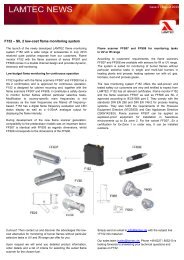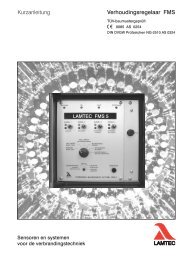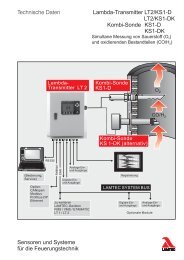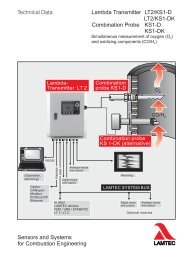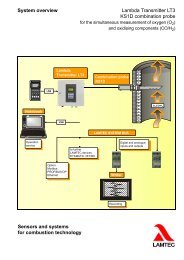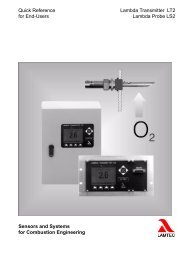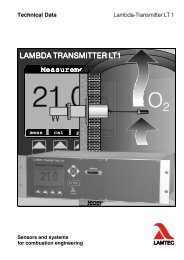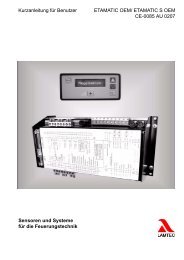Quick Reference for End-Users CarboSen1000 Sensors ... - lamtec
Quick Reference for End-Users CarboSen1000 Sensors ... - lamtec
Quick Reference for End-Users CarboSen1000 Sensors ... - lamtec
- No tags were found...
You also want an ePaper? Increase the reach of your titles
YUMPU automatically turns print PDFs into web optimized ePapers that Google loves.
11 FAQ11 FAQCan the sensor operate in condensed moisture?At present, there are two versions of the rod housing. The first type (NT) is designed <strong>for</strong> applicationsup to 150°C and can be operated under condensed moisture as long as the sensordoes not immerse into the condensation. The second type (HT) is designed <strong>for</strong> applications with a constant measuring temperature of150°C to 500°C. The clip housing is designed only <strong>for</strong> applications with ambient temperature up to 150°C.How should the sensor be installed?The best mounting position is upright, with the head / connection cable facing up. Should therebe a problem due to installation situation; the next best possible setting angle to choose fromis min 10° horizontally. An installation position below this horizontal level is to be avoided, becausethis could damage the sensor.What substances are considered to be harmful to <strong>CarboSen1000</strong>?Sulphur oxide, fluorine and chlorine compounds as well as silicon could be harmful to<strong>CarboSen1000</strong> and could cause a complete breakdown in extreme cases, depending on theconcentration. Also firm deposits on the sensor elements could affect the sensor characteristics, e.g. crystallisedsalt from condensation could interfere with the gas diffusion of the sensor.What are the effects of solid particles such as carbon and ash on the sensor?Carbon has no effect on the sensor and it does not contaminate the sensor. The sensor itselfhas a temperature of 630°C. There<strong>for</strong>e, carbon combustion occurs instantly at this ambienttemperature. Other solid particles in measuring gas such as ash would normally not end up inthe housing.Can I clean the sensor?Should it be necessary, the sensor housing can be wiped with a piece of dry cloth. Please beaware that the contaminated dirt should not be pressed against the plastic foil on the head ofthe sensor. Any kind of detergent or dissolver is not allowed in the cleaning the sensor.Does the temperature of the sensor drift?No. The sensor has a firm zero-point of ambient temperature, which can be given 0mV 5mV.What are the known effects of deterioration of the sensor?Some small inlet effects are known, which may occur during the first few hours of sensor operation.This effect could increase the sensitivity of the sensor. Deterioration effects such asdamage due to harmful substances depends very much on the type of substance used and itsconcentration (see above).What are the cross-sensitivity effects of <strong>CarboSen1000</strong>?<strong>CarboSen1000</strong> is a mixed potential sensor. Hence, it could detect all kinds of oxidisable, gaseoussubstance (CO e ), as well as those with different sensitivity. With the existence of multiplecomponents, this cannot be concluded selectively. Furthermore, the sensor voltage is dependent on the oxygen content in measuring gas. Thelower the oxygen content, the higher the sensor voltage while CO e being held constant. The <strong>CarboSen1000</strong> has no cross-sensitivity effects on H 2 0-vapour, CO 2 , inert gases.What are the effects of the sensor temperature on the sensor voltage?The sensor voltage is strongly temperature-dependent. The <strong>CarboSen1000</strong> operates in atemperature of 630°C. Possible operating temperature lies between 450°C and 700°C. As a44





